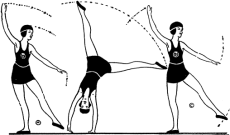By the term Engineering Drawing is meant drawing as used in the industrial world by engineers and designers, as the language in which is expressed and recorded the ideas and information necessary for the building of machines and structures; as distinguished from drawing as a fine art, as practised by artists in pictorial representation.
The artist strives to produce, either from the model or landscape before him, or through his creative imagination, a picture which will impart to the observer something as nearly as may be of the same mental impression as that produced by the object itself, or as that in the artist’s mind. As there are no lines in nature, if he is limited in his medium to lines instead of color and light and shade, he is able only to suggest his meaning, and must depend upon the observer’s imagination to supply the lack.
The engineering draftsman has a greater task. Limited to outline alone, he may not simply suggest his meaning, but must give exact and positive information regarding every detail of the machine or structure existing in his imagination. Thus drawing to him is more than pictorial representation; it is a complete graphical language, by whose aid he may describe minutely every operation necessary, and may keep a complete record of the work
for duplication or repairs.
In the artist’s case the result can be understood, in greater or less degree, by any one. The draftsman’s result does not show the object as it would appear to the eye when finished, consequently his drawing can be read and understood only by one trained in the language.
When this language is written exactly and accurately, it is done with the aid of mathematical instruments, and is called mechanical drawing. When done with the unaided hand, without the assistance of instruments or appliances, it is known as freehand drawing, or technical sketching. Training in both these methods is necessary for the engineer, the first to develop accuracy of measurement and manual dexterity, the second to train in comprehensive observation, and to give control and mastery of form and proportion.
Our object then is to study this language so that we may write it, express ourselves clearly to one familiar with it, and may read it readily when written by another. To do this we must know the alphabet, the grammar and the composition, and be familiar with the idioms, the accepted conventions and the abbreviations.
This new language is entirely a graphical or written one. It cannot be read aloud, but is interpreted by forming a mental picture of the subject represented; and the student’s success in it will be indicated not alone by his skill in execution, but by his ability to interpret his impressions, to visualize clearly in space.
http://www.archive.org/stream/manualofengineer00frenrich/manualofengineer00frenrich_djvu.txt



